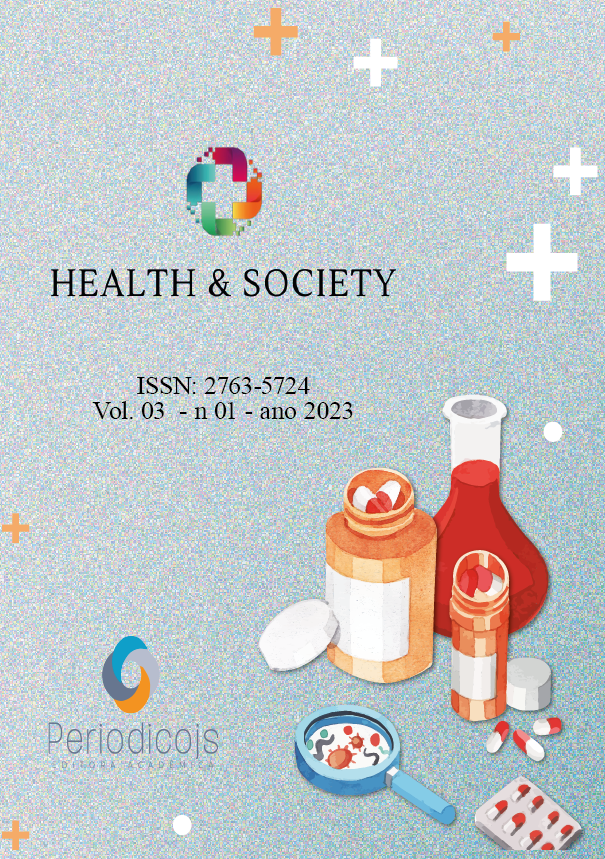Abstract
Botulinum toxin type A comes from a protein complex of the bacterium Clostridium botulinum, used in pharmacology and in aesthetic treatments to reduce facial expression lines. The objective of the study was to understand the pharmacological benefits and risks of using botulinum toxin Type A for aesthetic purposes. For this, the historical aspects, taxonomy, and physiology of Clostridium botulinum were presented; and the use of botulinum toxin type A was discussed in aesthetic procedures, its advantages, and disadvantages. The study methodology was a literature review of qualitative descriptive research, of works published between 2002 and 2019, in the databases VHL, BIREME, SCIELO, CNPQ and college websites. Among the results, botulinum toxin type A in aesthetic facial treatments, botulinum toxin reduces the wrinkles of the upper third of the face, such as raising eyebrows, frontal and cervical lines, among others; complications are pain, erythema and ecchymosis, the problems occur mainly in treatments such as pharmacology, due to high dosages in the body, or when associated with any health problem or medication. It is concluded that the prevention of complications with botulinum toxin type A is the anamnesis procedure before starting the facial treatment, so that the professional can raise problems of contraindication of this substance.
References
ANVISA - Agência Nacional de Vigilância Sanitária. Secretaria de Vigilância em saúde. Nota técnica conjunta nº 001/2011. Contaminação de Alimento pela Toxina Botulínica. Brasília, 2011.
BHUNIA, A. K. Foodborne microbial pathogens: mechanisms and pathogenesis. 2. ed. Alemanha: Editora Springer, 2018.
CARVALHO, Y. F. P. de; ROHLFS, D. B. Vigilância epidemiológica do botulismo alimentar. 2012. 14 f. (Pós-graduação) Universidade Católica de Goiás, Goiás, 2012.
CERESER, N. D. et al. Botulismo de origem alimentar. Ciência Rural, Santa Maria, v.38, n.1, p.280-287, jan./fev, 2008.
COLHADO, O. C. G.; BOEING, M.; ORTEGA, L. B. Toxina botulínica no tratamento da dor. Revista Brasileira de Anestesiologia, v. 59, n. 3, p. 366-381, maio/jun. 2009.
FACHIN, O. Fundamentos de metodologia. 5. ed. São Paulo: Saraiva, 2006.
FREITAS, G. W. de. Avaliação de potência de toxina botulínica tipo A por ensaios biológicos e método por cromatografia líquida em fase reversa. 2015. 64 f. Dissertação (Mestrado) – Universidade Federal de Santa Maria, Santa Maria (RS), 2015.
JULIANO, J. A. F.; CARDOSO, A. M. Clostridium botulinum e suas toxinas: uma reflexão sobre os aspectos relacionados ao botulismo de origem alimentar. Estudos, Goiânia, v. 41, n. 3, p. 657-670, jul./set. 2014.
KLEIN, F. H. de M. de S. et al. Remodelação facial inferior com toxina botulínica tipo A para o tratamento da hipertrofia masseter. Análise Brasileira de Dermatologia, v. 89, n. 5, p. 878-84, 2014.
MARCONI, M. A.; LAKATOS, E. M. Fundamentos da metodologia científica. 6. ed. São Paulo: Atlas, 2009.
MARQUES, J. R. S. A toxina botulínica: o seu uso clínico. 2014. 54 f. Dissertação (Mestrado) – Universidade Fernando Pessoa, Porto, Portugal, 2014.
MINAYO, M. C. S.; SUELY, D. F.; CRUZ, O. N.; GOMES, R. Pesquisa social: teoria, método e criatividade. Petrópolis; Rio de Janeiro: Vozes, 1996.
NETO, P. G. da S. G. Toxina botulínica tipo A: ações farmacológicas e riscos do uso nos procedimentos estéticos faciais. 2016. 44 f. Monografia (Especialista) – Instituto Nacional de Ensino Superior e Pesquisa, Centro de Capacitação Educaional, Recife, 2016.
OUAGARI, Z. et al. Botulismo na Casablanca. Bulletin de la Societé de Pathologie Exotique, Paris, v. 95, n. 4, p. 272- 275, 2002.
RIBEIRO, I et al. O uso da toxina botulínica tipo A nas rugas dinâmicas do terço superior da face. Revista da Universidade Ibirapuera, São Paulo, v.7, p. 31-37, jan./jun. 2014.
ROWLANDS, R. E. G. et al. Botulismo no Brasil, 2000-2008: epidemiologia, dados clínicos e diagnósticos laboratoriais. Revista Inst. Med. Trop., São Paulo, v. 52, n. 4, p. 183-186, jul./ago. 2010.
SANTOS, J. L.; MENDONÇA, M. A. Contaminação dos alimentos por botulismo: uma revisão. Anais... In: 7ª Amostra de produção científica da pós-graduação Latus Sensu da PUC de Goiás, Goiânia, 2012.
SPOSITO, M. M. de M. Toxina botulínica tipo A: propriedades farmacológicas e uso clínico. Acta Fisiátrica, v. 11, p. 7-44, 2004.
SUGANO, D. M.; FERNANDEZ, C. L.; REHDER, J. R. C. de L. Uso da toxina botulínica para correção de estrabismo. Revista Brasileira de Oftalmologia, v. 72, n. 5, p. 321-5, 2013.
ZAGUI, R. M. B.; MATAYOSHI, S.; MOURA, F. C. Efeitos adversos associados à aplicação de toxina botulínica na face: revisão sistemática com meta-análise. Arquivo Brasileiro de Oftalmologia, v. 71, n. 6, p. 894-901, 2008.

This work is licensed under a Creative Commons Attribution 4.0 International License.
Copyright (c) 2023 Andreza Sonego Furlan, Daniella Pilon Muknickas, Elka Bonetti, Brenda Ribeiro Marques, Ronaldo Barbosa Salvati, Stella Aparecida de Andrade Pinto, Roberto Teruo Suguihara





